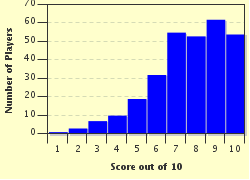Quiz Answer Key and Fun Facts
1. Berwick-upon-Tweed, in Northumberland, changed hands on numerous occasions between the twelfth and fifteenth centuries. Which country was England continually battling for ownership of the town?
2. The city of Seoul was captured and recaptured during five battles of the Korean War, which took place in which decade of the twentieth century?
3. The Golan Heights are a disputed area between Israel and Syria. Israel first took possession of the area in 1967 in a war commonly known by which name?
4. Between 1674 and 1814 ownership of the Caribbean island of Saint Lucia changed several times between Britain and which other European nation?
5. Toolse Castle changed hands several times during the Livonian War, before being destroyed in the Great Northern War. The ruins can be found in which Baltic country?
6. The American Civil War saw the city of Winchester suffer from numerous changes between the two sides. In which state did these battles take place?
7. The ancient city of Ctesiphon in Mesopotamia was captured on five separate occasions between 116 AD and 299 AD by which empire?
8. Although the Caribbean island of Dominica was originally claimed by France in 1635, the Seven Years' War saw it become a British possession under which, rather ironic, treaty?
9. The English Civil War saw many castles change ownership between the two sides. Which of these changed ownership on three occasions, even though it is not actually in England?
10. Hill 60 was a notorious battleground in Belgium which was fought over several times during which conflict?
Source: Author
rossian
This quiz was reviewed by FunTrivia editor
bloomsby before going online.
Any errors found in FunTrivia content are routinely corrected through our feedback system.

